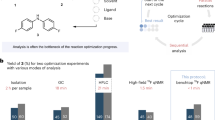Abstract
Quantitative 1H NMR spectroscopy was used to study chemical equilibria and reaction kinetics of both the formation and decomposition of 1,3,5-trioxane in aqueous formaldehyde solutions. The reaction was homogeneously catalyzed with up to 0.10 g g−1 sulfuric acid at temperatures between 360 and 383 K so that most of the experiments had to be carried out pressurized. The studied mixtures were complex due to the formation of methylene glycol and poly(oxymethylene) glycols in aqueous formaldehyde and the presence of considerable amounts of ionized species. Most common internal standards are decomposed by the hot sulfuric acid and external standards were not applicable using the flow NMR probe or pressurizable NMR sample tubes. Therefore, for the quantification of the small trioxane signals, a novel procedure was applied, in which electronically generated NMR signals were used as highly stable Virtual References (VR). The NMR decoupler channel with wave-form generator was used as the source of the reference signal, which was irradiated into the probe using the lock coil. Details on the experimental procedure are presented. It is shown that the presented method yields reliable quantitative reaction data for the complex studied mixtures.






Similar content being viewed by others
References
Reuss G, Disteldorf W, Gramer AO, Hilt A (2003) Ullmann’s Encyclopedia of Industrial Chemistry 15:1–35
Walker JF (1964) Formaldehyde. Reinhold ACS Monograph Series, New York
Sextro G (2003) Ullmann’s Encyclopedia of Industrial Chemistry 28:509–522
Balashov AL, Danov SM, Golovkin AY, Krasnov VL, Ponomarev AN, Borisova IA (1996) Russ J App Chem 69:190–192
Balashov AL, Danov SM, Krasnov VL, Chernov AY, Ryabova TA (2002) Russ J Gen Chem 72:744–747
Albert M (1999) Thermodynamische Eigenschaften formaldehydhaltiger Mischungen. Shaker, Aachen
Albert M, Garcia BC, Kuhnert C, Peschla R, Maurer G (2000) AIChE J 46:1676–1687
Hahnenstein I, Albert M, Hasse H, Kreiter CG, Maurer G (1995) Ind Eng Chem Res 34:440–450
Hahnenstein I, Hasse H, Kreiter CG, Maurer G (1994) Ind Eng Chem Res 33:1022–1029
Ott M, Fischer HH, Maiwald M, Albert K, Hasse H (2004) Chem Eng Proc 44:653–660
Ott M (2004) Reaktionskinetik und Destillation formaldehydhaltiger Mischungen. Shaker, Aachen
Maiwald M, Fischer HH, Ott M, Peschla R, Kuhnert C, Kreiter CG, Maurer G, Hasse H (2003) Ind Eng Chem Res 42:259–266
Maiwald M, Fischer HH, Kim Y-K, Albert K, Hasse H (2004) J Magn Reson 166:135–146
Moedritzer K, Van Wazer JR (1966) J Phys Chem 6:2025–2029
Elenkov D, Petrov PD, Tokarev D (1979) Chemie Ing Techn 42(8):546–548
Elenkov D, Petrov P, Grozev G (1969) Chemie Ing Techn 41(20):1128–1130
Bartholomé E, Köhler W, Schecker HG, Schulz G (1971) Chemie Ing Techn 43(10):597–601
Hasse H (1990) Dampf-Flüssigkeits-Gleichgewichte, Enthalpien und Reaktionskinetik in formaldehydhaltigen Mischungen. PhD Thesis, Kaiserslautern
Schecker H, Schulz G (1969) Z Phys Chem N F 65:221–224
Grützner T, Hasse H (2004) J Chem Eng Data 49:642–646
Burg KH, Hermann HD, Rehling H (1968) Die Makromol Chemie 111:181–193
Schilling K, Sohn M, Ströfer E, Hasse H (2003) Chemie Ing Techn 75:240–244
Mahon HP (1969) Rev Sci Instrum 40:1644–1645
Akoka S, Barantin L, Trierweiler M (1999) Anal Chem 71:2554–2557
Billault I, Akoka S (2000) Instrum Sci Technol 28:233–240
Silvestre V, Goupry S, Trierweiler M, Robins R, Akoka S (2001) Anal Chem 73:1862–1868
Akoka S, Trierweiler M (2002) Instr Sci Technol 30:21–29
Acknowledgements
The authors gratefully acknowledge the contributions of Florian Zieker, Johanna Schell, and Reeta Nording, Stuttgart, both for the experiments and their evaluation. Thanks are due also to Wolf Hiller, Varian Deutschland, Darmstadt, for help in implementing the Virtual Reference method. Financial support for this work by BASF AG, Ludwigshafen, is gratefully acknowledged.
Author information
Authors and Affiliations
Corresponding author
Rights and permissions
About this article
Cite this article
Maiwald, M., Grützner, T., Ströfer, E. et al. Quantitative NMR spectroscopy of complex technical mixtures using a virtual reference: chemical equilibria and reaction kinetics of formaldehyde–water–1,3,5-trioxane. Anal Bioanal Chem 385, 910–917 (2006). https://doi.org/10.1007/s00216-006-0477-3
Received:
Revised:
Accepted:
Published:
Issue Date:
DOI: https://doi.org/10.1007/s00216-006-0477-3




